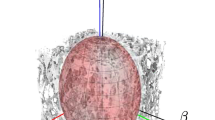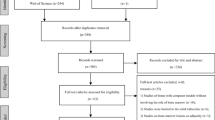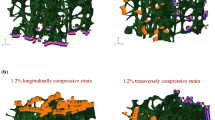Abstract
In the context of osteoporosis, evaluation of bone fracture risk and improved design of epiphyseal bone implants rely on accurate knowledge of the mechanical properties of trabecular bone. A multi-axial loading chamber was designed, built and applied to explore the compressive multi-axial yield and strength properties of human trabecular bone from different anatomical locations. A thorough experimental protocol was elaborated for extraction of cylindrical bone samples, assessment of their morphology by micro-computed tomography and application of different mechanical tests: torsion, uni-axial traction, uni-axial compression and multi-axial compression. A total of 128 bone samples were processed through the protocol and subjected to one of the mechanical tests up to yield and failure. The elastic data were analyzed using a tensorial fabric–elasticity relationship, while the yield and strength data were analyzed with fabric-based, conewise generalized Hill criteria. For each loading mode and more importantly for the combined results, strong relationships were demonstrated between volume fraction, fabric and the elastic, yield and strength properties of human trabecular bone. Despite the reviewed limitations, the obtained results will help improve the simulation of the damage behavior of human bones and bone-implant systems using the finite element method.
Similar content being viewed by others
References
Ashman RB, Rho JY, Turner CH (1989) Anatomical variation of orthotropic elastic moduli of the proximal human tibia. J Biomech 22(8/9): 895–900
Bayraktar HH, Gupta A, Kwon RY, Papadopoulos P, Keaveny TM (2004) The modified super-ellipsoid yield criterion for human trabecular bone. J Biomech Eng 126: 677–684
Bevill G, Easley SK, Keaveny TM (2007) Side-artifact errors in yield strength and elastic modulus for human trabecular bone and their dependence on bone volume fraction and anatomic site. J Biomech 40(15): 3381–3388
Bruyère-Garnier K, Dumas R, Rumelhart C, Arlot ME (1999) Mechanical characterization in shear of human femoral cancellous bone: torsion and shear tests. Med Eng Phys 21(9): 641–649
Carter DR, Schwab GH, Spengler DM (1980) Tensile fracture of cancellous bone. Acta Orthop Scand 51: 733–741
Chevalier Y, Pahr D, Allmer H, Charlebois M, Zysset P (2007) Validation of a voxel-based FE method for prediction of the uniaxial apparent modulus of human trabecular bone using macroscopic mechanical tests and nanoindentation. J Biomech 40(15): 3333–3340
Chung H, Wehrli FW, Williams JL, Kugelmass SD (1993) Relationship between nmr tranverse relaxation, trabecular bone architecture, and strength. Proc Natl Acad Sci USA 90: 10250–10254
Cowin SC (1985) The relationship between the elasticity tensor and the fabric tensor. Mech Mater 4: 137–147
Cowin SC (1986) Fabric dependence of an anisotropic strength criterion. Mech Mater 5: 251
Deshpande VS, Fleck NA (2000) Isotropic constitutive modeling for metallic foams. J Mech Phys Solids 48(6): 1253–1283
Feldkamp LA, Goldstein SA, Parfitt AM, Jesion G, Kleerekoper M (1989) The direct examination of three-dimensonal bone architecture in vitro by computed tomography. J Bone Miner Res 4(1): 3–11
Fenech CM, Keaveny TM (1999) A cellular solid criterion for predicting the axial-shear failure properties of bovine trabecular bone. J Biomech Eng 121: 414–422
Gibson LJ (2005) Biomechanics of cellular solids. J Biomech 38: 377–399
Gioux G, McCormack TM, Gibson LJ (2000) Failure of aluminum foams under multiaxial loads. Int J Mech Sci 42: 1097–1117
Gong JK, Arnold JS, Cohn H (1964) Composition of trabecular and cortical bone. Anat Rec 149: 325–332
Haiat G, Padilla F, Peyrin F, Laugier P (2007) Variation of ultrasonic parameters with microstructure and material properties of trabecular bone: a 3d model simulation. J Bone Miner Res 22(5): 665–674
Harrigan TP, Mann RW (1984) Characterization of microstructural anisotropy in orthotropic materials using a second rank tensor. J Mater Sci 19: 761–767
Harrigan TP, Jasty M, Mann RW, Harris WH (1988) Limitations of the continuum assumption in cancellous bone. J Biomech 21(4): 269–275
Hildebrand T, Laib A, Müller R, Dequeker J, Rüegsegger P (1999) Direct three dimensional morphometric analysis of human cancellous bone: microstructural data from spine, femur, iliac crest and calcaneus. J Bone Miner Res 14(7): 1167–1174
Hollister SJ, Brennan JM, Kikuchi N (1994) A homogenization sampling procedure for calculating trabecular bone effective stiffness and tissue level stress. J Biomech 27(4): 433–444
Kabel J, Van Rietbergen B, Odgaard A, Huiskes R (1997) Fabric and volume fraction can accurately predict mechanical properties for a wide range of trabecular architectures. In: Transactions of the 43rd annual meeting of the ORS, San Francisco, vol 2, p 800
Keaveny TM, Borchers RE, Gibson JG, Hayes WC (1993) Theoretical analysis of the experimental artifact in trabecular bone compressive modulus. J Biomech 26(4/5): 599–607
Keaveny TM, Wachtel EF, Ford CM, Hayes WC (1994) Differences between the tensile and compressive strength of bovine tibial trabecular bone depend on modulus. J Biomech 27: 1137–1146
Keaveny TM, Pinilla TP, Crawford RP, Kopperdahl DL, Lou A (1997) Systematic and random errors in compression testing of trabecular bone. J Orthop Res 15: 101–110
Keaveny TM, Wachtel EF, Zadesky SP, Arramon YP (1999) Application of the Tsai-wu quadratic multiaxial failure criterion to bovine trabecular bone. J Biomech Eng 121: 99–107
Keaveny TM, Morgan EF, Niebur GL, Yeh OC (2001) Biomechanics of trabecular bone. Annu Rev Biomed Eng 3: 307–333
Keller TS (1994) Predicting the compressive mechanical behavior of bone. J Biomech 27(9): 1159–1168
Ladd AJ, Kinney JH (1998) Numerical errors and uncertainties in finite-element modeling of trabecular bone. J Biomech 31: 941–945
Matsuura M, Eckstein F, Lochmüller EM, Zysset Ph (2007) The role of fabric in the quasi-static compressive mechanical properties of human trabecular bone from various anatomical locations. Biomech Model Mechanobiol 7(1):27–42
Meyer GH (1867) Die architektur der spongiosa. Arch Anat Physiol Wiss Med 34: 615–628
Morgan EF, Bayraktar HH, Keaveny TM (2003) Trabecular bone modulus–density relationships depend on anatomic site. J Biomech 36: 897–904
Müller R, Rüegsegger P (1995) Three-dimensional finite element modelling of non-invasively assessed trabecular bone structures. Med Eng Phys 17(2): 126–133
Müller R, Hahn M, Vogel M, Delling G, Rüegsegger P (1996) Morphometric analysis of noninvasively assessed bone biopsies: comparison of high-resolution computed tomography and histologic sections. Bone 18(3): 215–220
Nadai A (1950) Torsion of a round bar. The stress-strain curve in shear. In: Nadai A (ed) Theory of flow and fracture of solids, vol 1. McGraw-Hill, New York, pp. 347–352
Nazarian A, Müller R (2004) Time-lapsed microstructural imaging of bone failure behavior. J Biomech 37(1): 55–65
Niebur GL, Feldstein MJ, Yuen JC, Chen TJ, Keaveny TM (2000) High-resolution finite element models with tissue strength asymmetry accurately predict failure of trabecular bone. J Biomech 33(12): 1575–1583
Niebur GL, Feldstein MJ, Keaveny TM (2002) Biaxial failure behavior of bovine tibial trabecular bone. J Biomech Eng 124(6): 699–705
Odgaard A, Linde F (1991) The underestimation of Young’s modulus in compressive testing of cancellous bone specimens. J Biomech 24(8): 691–698
Pahr DH, Zysset PK (2007) Influence of boundary conditions on computed apparent elastic properties of cancellous bone. Biomech Model Mechanobiol doi:10.1007/s10237-007-0109-7
Parfitt AM (1984) Age-related structural changes in trabecular and cortical bone: cellular mechanisms and biomechanical consequences. Calcif Tissue Int 36: 123–128
Pietruszak S, Inglis D, Pande GN (1999) A fabric-dependent fracture criterion for bone. J Biomech 32: 1071–1079
Rauber AA (1876) Elastizität und Festigkeit der Knochen. Verlag Von Wilhelm Engelmann, Leipzig
Reilly DT, Burstein AH (1975) The elastic and ultimate properties of compact bone tissue. J Biomech 8: 393–405
Rice JC, Cowin SC, Bowman JA (1988) On the dependence of the elasticity and strength of cancellous bone on apparent density. J Biomech 21(2): 155–168
Rincón-Kohli L (2003) Identification of a multiaxial failure criterion for human trabecular bone. Ph.D., Swiss Federal Institute of Technology, Lausanne. http://library.epfl.ch/en/theses/
Rüegsegger P, Koller B, Müller R (1996) A microtomographic system for the nondestructive evaluation of bone architecture. Calcif Tissue Int 58: 24–29
Snyder BD, Hayes WC (1990) Multiaxial structure–property relations in trabecular bone. In: Mow VC, Ratcliffe A, Woo SL-Y (eds) Biomechanics of diarthrodial joints. Springer, New York, pp 31–59
Stone JL, Beaupre GS, Hayes WC (1983) Multiaxial strength characteristics of trabecular bone. J Biomech 16(9): 743–752
Triantafillou TC, Zhang J, Shercliff TL, Gibson LJ, Ashby MF (1989) Failure surfaces for cellular materials under multiaxial loads-II. comparison of models with experiment. Int J Mech Sci 31(9): 665–678
Turner CH, Cowin SC, Rho JY, Ashman RB, Rice JC (1990) The fabric dependance of the orthotropic elastic constants of cancellous bone. J Biomech 23: 549–561
Rietbergen B van (2001) Micro-FE analyses of bone: state of the art. Adv Exp Med Biol 496: 21–30
Rietbergen B van, Weinans H, Huiskes R, Odgaard A (1995) A new method to determine trabecular bone elastic properties and loading using micromechanical finite-element models. J Biomech 28(1): 69–81
Whitehouse WJ (1974) The quantitative morphology of anisotropic trabecular bone. J Microsc 101: 153–168
Wolff J (1892) Das Gesetz der Transformation der Knochen. A. Hirchwild, Berlin
Zhu M, Keller TS, Spengler DM (1994) Effects of specimen load-bearing and free surface layers on the compressive mechanical proerties of cellular materials. J Biomech 27(1): 57–66
Zysset Ph (2003) A review of fabric–elasticity relationships for human trabecular bone: theories and experiments. J Biomech 36: 1469–1485
Zysset Ph, Rincón-Kohli L (2006) An alternative fabric-based yield and failure criterion for trabecular bone. In: Holzapfel GA, Ogden RW (eds) Mechanics of biological tissue. Springer, Berlin, pp 457–470
Zysset Ph, Sonny M, Hayes WC (1994) Morphology–mechanical property relations in trabecular bone of the osteoarthritic proximal tibia. J Arthroplasty 9(2): 203–216
Author information
Authors and Affiliations
Corresponding author
Rights and permissions
About this article
Cite this article
Rincón-Kohli, L., Zysset, P.K. Multi-axial mechanical properties of human trabecular bone. Biomech Model Mechanobiol 8, 195–208 (2009). https://doi.org/10.1007/s10237-008-0128-z
Received:
Accepted:
Published:
Issue Date:
DOI: https://doi.org/10.1007/s10237-008-0128-z




